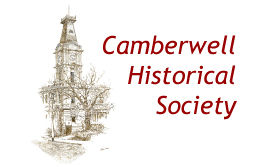Camberwell is 10 kilometres east of Melbourne’s CBD. One of the city’s more affluent suburbs, it grew from the area surveyed as the Parish of Boroondara by Robert Hoddle in 1838. ‘Boroondara’ translates from Woiwurrung as ‘where the ground is thickly shaded’. John Gardiner and his family were the first Europeans to settle there in 1837.
Between 1843 and 1853 all Boroondara land was sold. Speculators then subdivided and advertised smaller blocks with European placenames such as Auburn, Merrion, Clifton, Rathmines and Hartwell. The first local government body, the Boroondara District Road Board, was formed in 1854, incorporating areas later known as Hawthorn, Kew and Camberwell. In 1860 Hawthorn and Kew became separate municipalities. The remaining area of the Road Board became Boroondara Shire in 1871. This became the City of Camberwell in 1914.
The northern part of the Parish of Boroondara eventually became part of Camberwell City. Deriving from a special survey of 5120 acres (2072 hectares) acquired by Henry Elgar in 1841, it was sold to his associates when he returned to Sydney. Subsequent subdivision and sale saw farmhouses established in the area in the late 1840s and 1850s. Pioneer settler Andrew Murray purchased one subdivision, planted a vineyard and, in about 1858, built a house he named Balwyn (after Celtic ‘bal’ or hill and Saxon ‘wyn’ or wine), the site of which is now incorporated into Fintona Girls’ School. The district surrounding adjacent Balwyn Road’s intersection with Whitehorse Road became Balwyn.
Camberwell itself it thought to be named after an inn built in 1853 by George Eastaway on the corner of several converging roads and named the Camberwell Inn because it reminded Eastaway of Camberwell Green in London. The area took the name of Camberwell and the busy intersection of streets, today known as Camberwell Junction, became a stopping point to the Gippsland gold diggings.
The Prospect Hill area is the oldest part of the suburb. The original subdivision comprised generous blocks on which fine Victorian and Edwardian houses were built. As with most of Boroondara Parish, the first mansions were erected on hilltops for the views and fresh air, most with large gardens and main road addresses. Apart from a few large houses like Sir John O’Shanassy’s Tara, residential development was limited before the railway connection in 1882.
Anglican Church services began in Camberwell in 1856, and the first St John’s Church was opened in 1863. The Catholic Church site was established in 1859 but the current Our Lady of Victories was not opened till 1918 and only consecrated in 1925. Camberwell Post Office opened on 12 October 1864 and by 1890 a grand new Post Office had been built. Camberwell Primary School (No. 888) commenced teaching in 1867, the current school retaining its Victorian frontage and part of the original building. A shire hall built in 1871 was replaced by the free classical–style town hall on Camberwell Road in 1890, the clock tower with mansard roof being added in 1924 as a memorial.
The extension of the railway in 1882 brought the area firmly into the orbit of Melbourne and, over the ensuing two decades, the population grew from 1,400 to 6,000. The main commercial centre developed along Burke Road and around Camberwell Junction. Major buildings included the Commercial Bank opened in 1889 and the Palace Hotel whose foundation stone was laid in 1888. By 1919 Camberwell had seven hotels but a state-wide local option poll in 1920 saw the city’s residents vote to close all of them, including the Camberwell Inn. The Palace Hotel, strategically placed opposite Camberwell station, survived because it was on the Hawthorn side of Burke Road.
The suburb developed further in the interwar years because the electric tram routes, which were established in 1916-17 along Burke, Riversdale and Camberwell roads, promoted residential subdivision on new estates in south Camberwell, middle Camberwell and Hartwell. The electrification of the train lines in 1916 stimulated growth and the Outer Circle Railway branch from East Camberwell to Ashburton reopened and extended to Alamein. Burke Road boomed in the 1920s. Large estates were broken up after the introduction of rates on unimproved land values. One of the features of the suburb is brick housing, mandated by Council bye-laws for many precincts from the early twentieth century. The Californian bungalow became the characteristic housing style of the area.
Rapid growth caused changes to the municipal structure; in 1902 the area was proclaimed as the Shire of Camberwell and Boroondara; 1905 saw it as the Borough of Camberwell and Boroondara; 1906 the Town of Camberwell; and 1914 as the City of Camberwell.
The former Cities of Camberwell, Hawthorn and Kew were re-amalgamated on 22 June 1994 to form the City of Boroondara.
